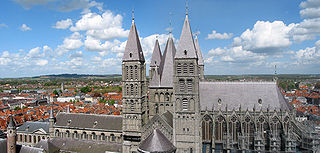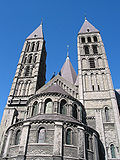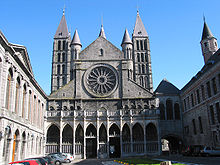- Tournai Cathedral
-
Our Lady of Tournai
Notre-Dame de Tournai (French)
Onze-Lieve-Vrouw van Doornik (Dutch)
View of the five Romanesque towers of the cathedral of Tournai (XII century)
Basic information Location Tournai, Hainaut, Belgium Geographic coordinates 50°36′23.58″N 3°23′19.89″E / 50.60655°N 3.3888583°ECoordinates: 50°36′23.58″N 3°23′19.89″E / 50.60655°N 3.3888583°E Affiliation Roman Catholic District Diocese of Tournai Ecclesiastical or organizational status Cathedral Heritage designation 1936, 2000 Leadership Bishop Guy Harpigny Website www.cathedrale-tournai.be Architectural description Architect(s) Building: unknown [1]
Sacristy: G. Hersecap[1]
Holy Spirit chapel: Simon Vollant[1]Architectural type Church Architectural style Romanesque, Gothic, French Baroque Direction of façade NW Groundbreaking Nave: 1140 et 1171[2]
Transepts: 1199-1213[1]
Transept vaults: 1243-1255[1]
Gothic choir:1243-1255[1]
Sacristy: 1676[1]
Holy Spirit chapel: 1680[1] [3]Completed 1700[1] Specifications Length 134 metres (440 ft) Width 60 metres (200 ft) Width (nave) 20 metres (66 ft) Height (max) 83 metres (272 ft) Spire(s) 5 (7 planned) Spire height 83 metres (272 ft) UNESCO World Heritage Site Official name: Notre-Dame Cathedral in Tournai Criteria: ii, iv Designated: 2000[4] Reference #: 1009 Type: Cultural State Party:  Belgium
BelgiumRegion: Europe and North America The Cathedral of Our Lady (French: Notre-Dame de Tournai, Dutch: Onze-Lieve-Vrouw van Doornik) is Roman Catholic church, see of the Diocese of Tournai in Tournai, Belgium. It has been classified both as a Wallonia's major heritage since 1936[5] and as a World Heritage Site since 2000.
Contents
History
There was a diocese centered at Tournai from the late sixth century and this structure of local blue-gray stone occupies rising ground near the south bank of the Scheldt, which divides the city of Tournai into two roughly equal parts. Begun in the 12th century on even older foundations, the building combines the work of three design periods with striking effect, the heavy and severe character of the Romanesque nave contrasting remarkably with the Transitional work of the transept and the fully developed Gothic of the choir. The transept is the most distinctive part of the building, with its cluster of five bell towers and apsidal (semicircular) ends.
The nave belongs mostly to the first third of the 12th century. Prefiguring the Early Gothic style, it has a second-tier gallery between the ground-floor arcade and the triforium. Pilasters between the round-arched windows in the clerestory help support the 18th-century vaulting that replaced the original ceiling, which was of wood, and flat.
The transept arms, built in about the mid-12th century, have apsidal ends, a feature borrowed in all probability from certain Rhenish churches, and which would appear to have made its influence felt in the northeast of France, as at Noyon and Soissons. The square towers that flank the transept arms reach a height of 83 metres (272 ft). They vary in detail, some of the arcade work with which they are enriched being in the round-arched and some in the pointed style.
Bishop Gautier de Marvis (1219-1252) had the original Romanesque choir demolished in the 13th Century, in order to replace it with a Gothic choir of much grander dimensions, inspired by the likes of Amiens Cathedral. The construction of the new choir began in 1242, and ended in 1255. The rest of the cathedral was supposed to be rebuilt in the same style as the choir, but this was never attempted, the only later additions being the western porch, and a large Gothic chapel which was built alongside one of the side aisles, whose original walls and windows disappeared in the process.
The Cathedral was damaged by a severe tornado on the 24 August 1999. Assessment of the damage revealed underlying structural problems and the Cathedral has been undergoing extensive repairs and archaeological investigation ever since. The Brunin Tower was stabilised in 2003.
In recognition of the Tournai cathedral's cultural value, UNESCO designated the building a World Heritage Site in the year 2000.
Burials
- Eleuterius of Tournai
- Nicolas Gombert
Specifications
- Total length: 134 metres (440 ft)
- Towers
- Number: 5
- Height: 83 metres (272 ft)
- Nave
- Height: 26 metres (85 ft)
- Length: 48 metres (157 ft)
- Width : 20 metres (66 ft)
- Choir
- Height: 58 metres (190 ft)
- Width: 36 metres (118 ft)
- Transept
- Height: 48 metres (157 ft)
- Length: 66.5 metres (218 ft)
- Width : 14 metres (46 ft)
Gallery
-
"The issue of souls in purgatory" c. 1635, Peter Paul Rubens
-
Rose window (Charles Benvignat J-B Capronier - XIXth century) and the large pipe organ (P-A Ducroquet - 1854)
See also
References
- Citations
- ^ a b c d e f g h i http://www.kikirpa.be/www2/cgi-bin/wwwopac.exe?DATABASE=obj2&LANGUAGE=0&OPAC_URL=&10059791=ON&LIMIT=200 "Decription of the Cathedral of Our Lady of Tournai". Picture Library. Royal Institute for the Study and Conservation of Belgium's Artistic Heritage. http://www.kikirpa.be/www2/cgi-bin/wwwopac.exe?DATABASE=obj2&LANGUAGE=0&OPAC_URL=&10059791=ON&LIMIT=200 http://www.kikirpa.be/www2/cgi-bin/wwwopac.exe?DATABASE=obj2&LANGUAGE=0&OPAC_URL=&10059791=ON&LIMIT=200. Retrieved 7 July 2011.
- ^ Bony 1983, p. 159
- ^ Cathédrale Notre-Dame de Tournai. "La chapelle du Saint-Esprit" (in French). Official website. Diocèse de Tournai. http://www.cathedrale-tournai.be/cathedraletournai/fr/7025-la-chapelle-du-saint-esprit.html. Retrieved 7 July 2011.
- ^ "Notre-Dame Cathedral in Tournai". Whc.unesco.org. http://whc.unesco.org/en/list/1009. Retrieved 7 July 2011.
- ^ "L'ensemble de la Cathédrale Notre-Dame à l'exception de l'orgue de choeur (partie instrumentale et buffet)" (in French). Patrimoine Wallon. Direction de la Protection - Région Wallone. http://lampspw.wallonie.be/dgo4/site_thema/index.php?details=57081-PEX-0001-01&thema=pat_exc. Retrieved 7 July 2011. - n° 57081-CLT-0002-01 - 5 February 1936
- Bibliography
- "Tournai Cathedral (Belgium)". Evaluation by ICOMOS. UNESCO. 2000. http://whc.unesco.org/archive/advisory_body_evaluation/1009.pdf. Retrieved 7 July 2011.
- Bony, Jean (1983). French Gothic architecture of the 12th and 13th centuries. Berkeley: University of California Press. ISBN 9780520055865. http://books.google.com/books?id=k7ytJ-gXonMC&pg=PA159#v=onepage&q&f=false.
External links
 Media related to Cathédrale Notre-Dame, Tournai at Wikimedia Commons
Media related to Cathédrale Notre-Dame, Tournai at Wikimedia Commons- "Complete catalog of images of the Cathedral of Our Lady of Tournai". Picture Library. Royal Institute for the Study and Conservation of Belgium's Artistic Heritage. http://www.kikirpa.be/www2/cgi-bin/wwwopac.exe?DATABASE=fotos2&LANGUAGE=2&OPAC_URL=&72650=on. Retrieved 7 July 2011.
- "Arhitectural images of the Cathedral of Our Lady of Tournai". Picture Library. Royal Institute for the Study and Conservation of Belgium's Artistic Heritage. http://www.kikirpa.be/www2/cgi-bin/wwwopac.exe?DATABASE=fotos2&LANGUAGE=0©TEXT=©RIGHT=&OPAC_URL=&10059791=on. Retrieved 7 July 2011.
- Tournai: Our Lady's Cathedral - from Belgium Travel Network
- Tournai Cathedral (pdf) - UNESCO site, contains detailed description and history
- Cathedral Notre-Dame - from official site of the city of Tournai
World Heritage Sites in Belgium Brussels Flanders Belfries of Belgium and France1 · Bruges (historic centre) · Flemish Béguinages · Plantin-Moretus House-Workshops-Museum ComplexWallonia Belfries of Belgium and France1 · Four Lifts on the Canal du Centre and their Environs, La Louvière and Le Rœulx, Hainault · Neolithic flint mines at Spiennes · Notre-Dame Cathedral of Tournai1 Shared locally with other regions and with FranceCategories:- Wallonia's Major Heritage
- Cathedrals in Belgium
- World Heritage Sites in Belgium
- 1250s architecture
- 12th-century church buildings
- Romanesque architecture in Belgium
- Gothic architecture in Belgium
Wikimedia Foundation. 2010.








